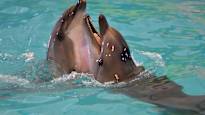However, some researchers warn against drawing too far-reaching conclusions about dolphin behavior.
Animal researchers from the University of Pisa in Italy report that they have identified dolphin gestures that can be linked to playfulness with their fellow species.
Dolphins’ play is, for example, spinning around their partner and light pushing.
The researchers found that in play situations, the dolphins opened their mouths, and the partner immediately responded.
Animal behavior researcher at the University of Pisa Elisabetta Palagi is convinced that the opening of dolphins’ mouths during play is proportional to the smile or laughter of humans.
Similar behavior did not occur in other situations. Dolphins could indeed open their mouths in violent situations, but at that time they immediately tried to bite their fellow species that was nearby.
The researchers followed two groups of bottlenose dolphins (Tursiops truncates), one in a marine park in Rome and the other in a wildlife park in western France. About 80 hours of video footage of the dolphins’ activities was collected.
The researchers found that the dolphins tended to open their mouths while playing, but this only happened when the dolphin had a play partner nearby and in its field of vision. Every third time, the play partner also opened his mouth immediately, within less than a second.
Dolphins also play alone, for example by pushing objects at the bottom of the water or splashing water. However, mouth opening did not occur at all when the dolphins were playing alone.
The study has been published in the iScience publicationand it was reported by, among others, a British newspaper Independent magazine.
Some researchers are not convinced
Some researchers warn against drawing too far-reaching conclusions about animal behavior and humanizing animals too much.
of the Science.org publication interviewed by a marine mammal biologist at the University of St. Andrews Peter Tyack points out that the real reason for the dolphins’ behavior is unknown.
Animals have often been found to only imitate the movements of another. In addition, Tyack would like to see dolphin behavior studied as a whole, not just mouth movements.
In the same publication, a behavioral researcher at the Dolphin Research Institute in Chicago Kathryn Holmes wants to know if dolphins in the wild do the same.
The dolphins he studies live in murky waters, where spotting one another is more difficult. Holmes would be interested to know if dolphins open their mouths to their mate if the other cannot be seen properly due to the turbidity of the water.
